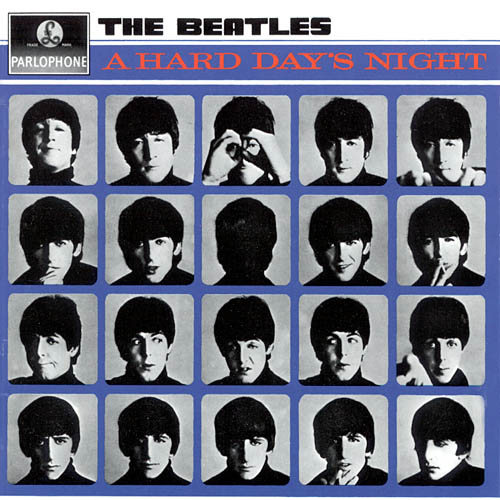
A Hard Day's Night (1964)

1.A Hard Day's Night
2.I Should Have Known Better
3.If I Fell
4.I'm Happy Just To Dance With You
5.And I Love Her
6.Tell Me Why
7.Can't Buy Me Love
8.Anytime At All
9.I'll Cry Instead
10.Things We Said Today
11.When I Get Home
12.You Can't Do That
13.I'll Be Back
By mid-1964, Beatlemania had reached a fever pitch. The band’s tours were sellouts, their faces plastered across newspapers and teen magazines on both sides of the Atlantic. The public had declared them invincible. What followed—astonishingly—was an album that not only lived up to the hype but transcended it. A Hard Day’s Night was not just a successful third LP; it was the clearest indication yet that the Beatles were rapidly evolving into artists of formidable vision and versatility.
For the first time, the Beatles eschewed cover material entirely, opting instead for a complete set of Lennon–McCartney originals—thirteen in total. In doing so, they set a new standard for self-contained rock bands. The album also coincided with their first feature film of the same name, a surprisingly witty and well-made piece of pop cinema that helped define their public image as cheeky yet charming working-class heroes.
The title track, with its iconic clanging opening chord, is one of the band’s great achievements. It is energetic, melodic, and lyrically clever—a perfect distillation of their appeal at the time. Equally enduring is Can’t Buy Me Love, a track that embodies the early Beatles formula: buoyant, economical, and irresistibly catchy. These two songs may be the most widely remembered, but the strength of the album lies in its depth.
I Should Have Known Better, If I Fell, and Things We Said Today reveal a growing maturity, particularly in Lennon’s lyricism and in the band’s approach to harmony and acoustic textures. The ballads are wistful, the upbeat tracks are driving and clean, and even the slightly rougher numbers—I’ll Cry Instead and When I Get Home—add contrast and emotion. The former, with its country-rock twang, shows Lennon stretching into new territory. The latter, though vocally strident to the point of near-overexertion, masks a solid pop structure beneath its bluster.
Curiously, there is no Ringo vocal on this album—his only omission in the band's core catalog. That absence, while noticeable, does not diminish the record’s cohesion. The group’s internal dynamics seem in perfect alignment here: George Harrison’s guitar work is crisp and increasingly sophisticated, Paul McCartney’s bass lines are fluid and inventive, and the Lennon–McCartney songwriting partnership is operating at full throttle. The hidden gem of the album is arguably If I Fell, a tender Lennon ballad featuring one of the band’s most delicate and affecting two-part harmonies. Its emotional vulnerability and melodic subtlety would have seemed improbable just eighteen months earlier, when the band was still mining the energy of early rock and roll.
If With the Beatles had refined the band's sound and focus, A Hard Day’s Night solidified their dominance—not merely as a cultural phenomenon but as musicians with the ambition and ability to shape the direction of modern pop music. This album, then, marks the end of the Beatles’ first phase. It is the last time they would operate fully within the template of early '60s pop. What came next would be bolder, stranger, and more experimental. But A Hard Day’s Night was the apex of their initial ascent—a perfect storm of songwriting, charisma, and cultural timing.